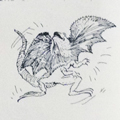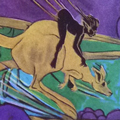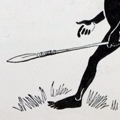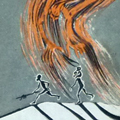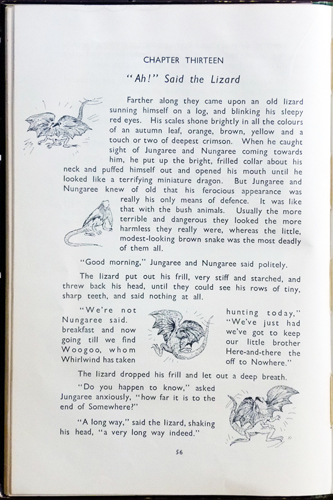Elizabeth Durack was a fine and imaginative illustrator —
one who pushed the wide boundaries of the genre — as the eight books here, and many others, reveal.
Her professional life started as collaborator–illlustrator
with her sister, Mary Durack, their first published work appearing in the 1934
Christmas edition of Perth’s The Western Mail. For the next ten years the sisters
collaborated closely despite often being separated by vast distances.
When, soon after the war Elizabeth began to express herself independently as a painter she met opposition from the taste-makers of the day. Critics had
been prepared to acknowledge she could draw but — for reasons open to speculation — were not prepared to admit her work
into the hallowed halls of 'high art'. Had critics been less cocooned or locked into sanctioned patterns of thought they’d
have detected even within The Whirlwind’s colour plates, a radical vision of Australian
landscape; one bound to break from the confines of the
printed page. The Whirlwind’s striking cover sets a style and a theme. Its
strong sense of movement was to carry over into much of Elizabeth’s later work.
(The elongated hands and fingers of the mischievous wind spirit are also
noteworthy. Compare William Dobell’s similar treatment of the hands in his famous
portrait of Joshua Smith painted a year or so after The Whirlwind appeared.
Dobell and Durack were living in Sydney at the time and were acquainted.)
#
The first edition of The Way of the Whirlwind, (Consolidated
Press, Sydney, 1941) was a lavish publication (particularly for a children’s
book produced during war-time.) It was a 37 x 24.5 cm hard-back book, hand-stitched,
jacketed and cloth bound. Its 80 pages were illustrated throughout and included
front and end-pieces and tipped-in plates, 9 in full colour.
The story is about the adventures of Nungaree and Jungaree as
they search for their baby brother Woogoo who has been stolen by ‘Here and There’,
the Whirlwind. The work has been widely acclaimed. It combines the style of traditional European folk tales with Aboriginal mythology. Its colour plates evoke the Dreaming while its
black and white drawings belong to the more realistic level on which the story moves along. By the 1950s the large format discontinued but The Whirlwind
remained popular. It ran into many editions and was in print for almost 40
years. By 1979 — the year of its last edition — gatekeepers had moved in ...
The Way of the Whirlwind was
Mary and Elizabeth’s fifth
published collaboration. It followed All-About
(1935), Chunuma (1936),
Son of
Djaro (1940) and Piccaninnies (1940).
#
